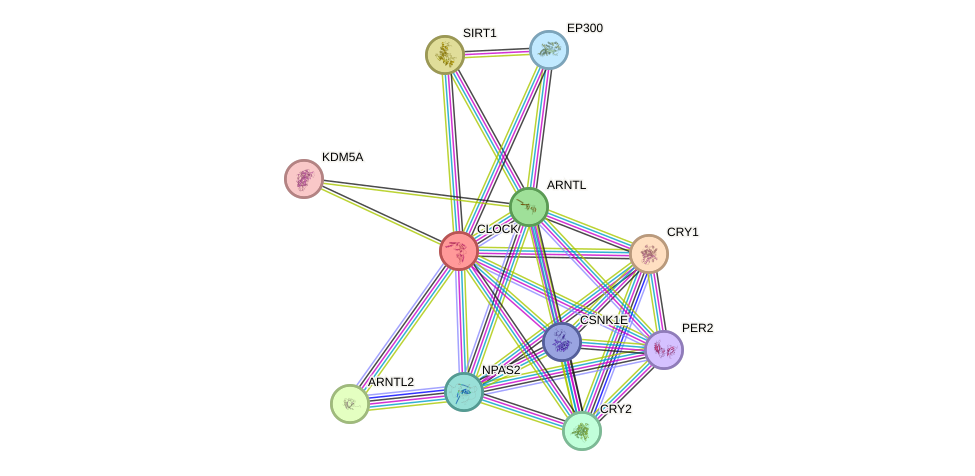GenAge entry for CLOCK (Homo sapiens)
Gene name (HAGRID: 252)
- HGNC symbol
- CLOCK
- Aliases
- KIAA0334; KAT13D; bHLHe8
- Common name
- clock circadian regulator
Potential relevance to the human ageing process
- Main reason for selection
- Entry selected based on evidence linking the gene product to a pathway or mechanism linked to ageing
- Description
CLOCK forms a heterodimer with ARNTL, which activates circadian rhythm-associated genes. Mice deficient in ARNTL have an impaired circadian behavior, reduced lifespan, and display symptoms of premature ageing associated in some tissues with increased levels of reactive oxygen species [1841][2134]. CLOCK mutant mice do not display predisposition to tumour formation. When challenged with low-dose irradiation, however, they appear to accelerate their ageing program and develop a phenotype reminiscent of ARNTL-deficient mice [1842]. ARNTL and CLOCK also appear to be involved in the response to genotoxic stress [1868]. Overall, CLOCK might play some role in mammalian ageing.
Cytogenetic information
- Cytogenetic band
- 4q12
- Location
- 55,427,901 bp to 55,546,909 bp
- Orientation
- Minus strand
Protein information
- Gene Ontology
-
Process: GO:0000077; DNA damage checkpoint
GO:0006355; regulation of transcription, DNA-templated
GO:0006357; regulation of transcription from RNA polymerase II promoter
GO:0006366; transcription from RNA polymerase II promoter
GO:0007165; signal transduction
GO:0007283; spermatogenesis
GO:0007623; circadian rhythm
GO:0009648; photoperiodism
GO:0016573; histone acetylation
GO:0032922; circadian regulation of gene expression
GO:0042634; regulation of hair cycle
GO:0043161; proteasome-mediated ubiquitin-dependent protein catabolic process
GO:0045892; negative regulation of transcription, DNA-templated
GO:0045893; positive regulation of transcription, DNA-templated
GO:0045944; positive regulation of transcription from RNA polymerase II promoter
GO:0050729; positive regulation of inflammatory response
GO:0050796; regulation of insulin secretion
GO:0051092; positive regulation of NF-kappaB transcription factor activity
GO:0051775; response to redox state
GO:0071479; cellular response to ionizing radiation
GO:2000074; regulation of type B pancreatic cell development
GO:2000323; negative regulation of glucocorticoid receptor signaling pathway
Cellular component: GO:0005634; nucleus
GO:0005654; nucleoplasm
GO:0005667; transcription factor complex
GO:0005694; chromosome
GO:0033391; chromatoid body
GO:0043231; intracellular membrane-bounded organelle
Hide GO termsFunction: GO:0000978; RNA polymerase II core promoter proximal region sequence-specific DNA binding
GO:0000982; transcription factor activity, RNA polymerase II core promoter proximal region sequence-specific binding
GO:0001046; core promoter sequence-specific DNA binding
GO:0001047; core promoter binding
GO:0001190; transcriptional activator activity, RNA polymerase II transcription factor binding
GO:0003677; DNA binding
GO:0003700; transcription factor activity, sequence-specific DNA binding
GO:0004402; histone acetyltransferase activity
GO:0005515; protein binding
GO:0031490; chromatin DNA binding
GO:0043565; sequence-specific DNA binding
GO:0046983; protein dimerization activity
GO:0070888; E-box binding
Protein interactions and network
- Protein-protein interacting partners in GenAge
- CREBBP, EP300, SIRT1, PPP1CA, CSNK1E, ARNTL
- STRING interaction network
Retrieve sequences for CLOCK
Homologs in model organisms
In other databases
- GenAge model organism genes
- A homolog of this gene for Mus musculus is present as Clock
- LongevityMap
- This gene is present as CLOCK

